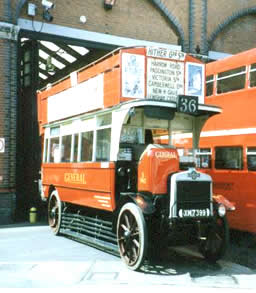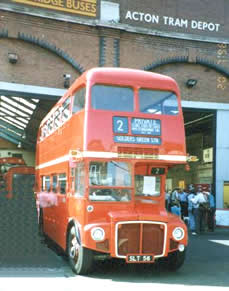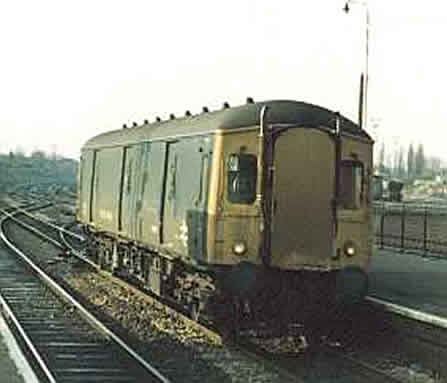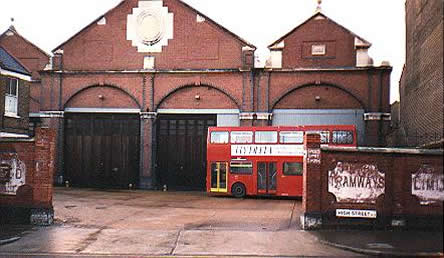The Tram Depot
The walls say "London United Tramways Limited"


Acton Tram Depot Open Day 20th July 1996.
The Horse Tram Service from Shepherds Bush was extended to Acton Hill in 1895. A plot of land at the top of the hill was purchased from C R Round for the sum of £1,094. The Tram depot and stables ,together with a large paddock for the horses were constructed. The Tram Line was converted to electric operation in 1901, and the service was extended to Southall. The depot could house up to 35 electric trams. The redundant paddock was used for the construction of houses fronting
In constructing the depot, the Red Lion and the Pineapple public houses were demolished, and replaced by a new establishment with the combined name of the Red Lion and Pineapple.
On the front wall, it is still possible to make out the words, London United Tramways Limited. The depot was converted for use by trolley busses in 1936, but in 1937, the depot was closed, and used as a store for electrical equipment. The depot became operational again as a bus depot in 1990.

Is
Trams
The horse drawn West Metropolitan Tramway opened to from Shepherds Bush to
London General Omnibus Company
The introduction of the trams prompted the London General Omnibus Company to improve its services, and it introduced through services to central
The London General Omnibus Company opened its Central Overhaul works at Chiswick in 1921, and brought together the work previously done in 30 other garages to a central point. This action reduced the time to overhaul a vehicle from 16 days to 4 days, giving a 3½% improvement in availability. In addition to overhaul, the works also built the complete bodies for a number of vehicles. The works extended to some 31 acres, employing 1200 staff and maintaining fleets of about 6000 vehicles. During the war London Transport co-ordinated the London Aircraft Production and Chiswick Works manufactured parts for
After the war, Chiswick concentrated on the overhaul of vehicle parts, feeding the production line at the Aldenham Works. Changes in vehicle manufacturing techniques and policies of decentralisation reduced the workload at the Chiswick Works during the 1980’s and the site has been closed, and sold for development.

Open-top Routemaster in Acton
Park Royal Vehicles
Hall, Lewis and Co. had its origins in
The AEC company, formed as a subsidiary of the London General Omnibus Company, manufactured considerable numbers of bus chassis for use in
The company had a competitor in the form of Strachn and Brown, Coachbuilders, who moved to
Manufacturing some 1000 bus bodies per year, the company became becoming one of the largest suppliers in the country, selling to many provincial bus companies, in the
Although buses were now the main product, the Company built a small number of rail vehicles including four single unit diesel railcars for the Great Western Railway in 1934, and a batch of 20 two unit diesel multiple units for British Railways in 1957. In both cases, the mechanical parts and engines were supplied by AEC.
In 1949, the Company became part of the Associated Commercial Vehicles Group, and there was an increased co-operation with AEC, also part of the group. The style of vehicle construction was changing, from one in which the chassis and the body were separate entities, and usually manufactured by separate companies, to one in which the vehicle was a single construction, a strengthened vehicle body taking the role of the separate chassis. Although, the AEC / Park Royal partnership had produced many vehicles for London Transport, their greatest success came in 1958 with the design and construction of nearly 2000 of the Routemaster buses for
Park Royal Vehicles became part of British Leyland in 1962, but production declined as competition from private cars and other manufacturers increased, and the works finally closed in July, 1980, the remaining business being concentrated at other British Leyland factories. The Park Royal site has been re-developed as a thriving business park.

A trolley bus at

Acton Central level crossing.
70013 Oliver Cromwell passing Bollo Lane crossing (2009)

A Motor Parcel Van passing through Acton Main Line
34067 Tangmere passing Acton main line October 2011.
The Railway Expansion
The gradual expansion of
The arrival of the North and South Western Junction Railway at
The District Railway arrived in 1879 at Acton Green (now Chiswick Park) and
The Great Western Railway passed through
The railway had a direct influence on local development in the construction in the 1920’s, of the Great Western Railway Garden Estate alongside the
In the North of the parish, the
The Central Line of the Underground completes the rail links with the opening of stations at East Acton (1920), North Acton and
